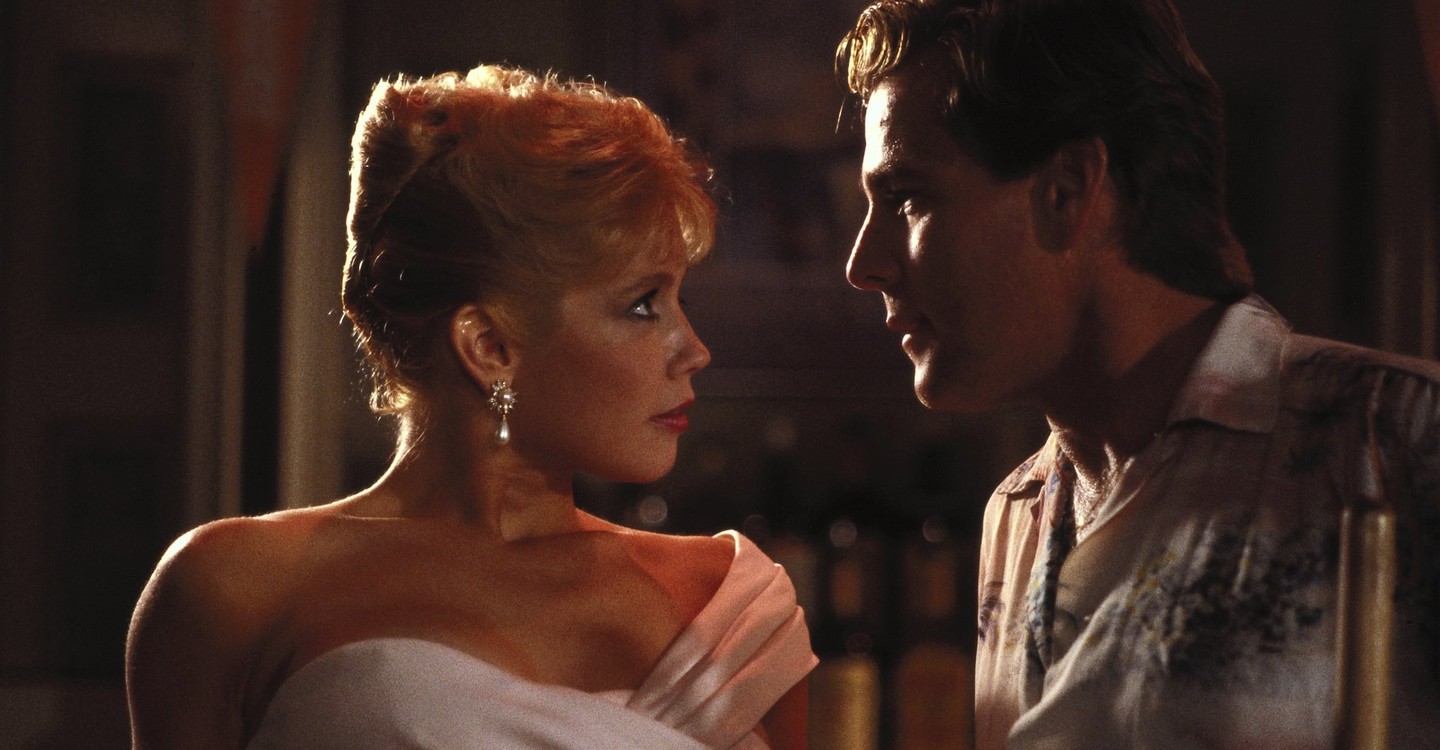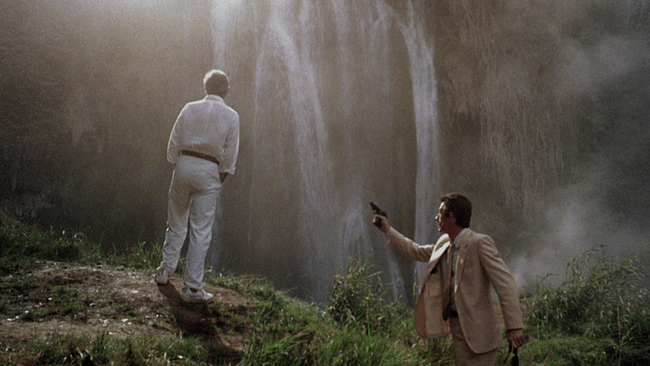By Dennis Hartley
(Originally posted on Digby’s Hullabaloo on February 5, 2022)
 “Hey buddy-could you direct me to the Ark of the Covenant?”
“Hey buddy-could you direct me to the Ark of the Covenant?”
Life IS pain, Highness. Anyone who says differently is selling something.
-from The Princess Bride (screenplay by William Goldman)
“How can a guy get so low?” Even within the dark recesses of film noir, the cynical 1947 genre entry Nightmare Alley is about as “low” as you can get. Directed by Edmund Goulding and adapted from William Lindsay Gresham’s novel by Jules Furthman, the film was a career gamble for star Tyrone Power, who really sunk his teeth into the role of carny-barker-turned “mentalist” Stanton Carlisle.
Utilizing his innate charm and good looks, the ambitious Carlisle ingratiates himself with a veteran carnival mind-reader (Joan Blondell). Once he finagles a few tricks of the trade from her, he woos a hot young sideshow performer (Coleen Gray) and talks her into partnering up to develop their own mentalist act.
The newlyweds find success on the nightclub circuit, but the ever-scheming Carlisle soon sees an opportunity to play a long con with a potentially big payoff. To pull this off, he seeks the assistance of a local shrink (Helen Walker). While not immune to Carlisle’s charms, she is not going to be an easy pushover like the other women in his life. Big trouble ahead…and a race back to the bottom.
The film was considered such a downer that 20th-Century Fox all but buried it following its first run. In addition, legal tangles barred it from being reissued in any home video format until a 2005 DVD release. I was one of those noir geeks who literally jumped for joy when I heard the glorious news. I was even more excited when the Criterion Collection released a Blu-ray in 2021 that featured a sparkling new 4k digital restoration.
It was about the same time as the Criterion reissue last summer that I first heard there was a remake in the wings, scheduled for a December 2021 release. I found the timing…interesting but shrugged and figured that if the new production had somehow expedited the long-overdue restoration and reissue of Goulding’s original version, then (to re-appropriate Elliott Gould’s catchphrase from Robert Altman’s 1973 adaptation of Raymond Chandler’s The Long Goodbye) “…it’s okay with me.”
After a relatively brief time in theaters, Guillermo del Toro’s Nightmare Alley (adapted from Gresham’s novel by the director and Kim Morgan) has pulled up stakes, loaded up the wagons, and (as of February 1st) moved the carnival to HBO Max and Hulu.
Remakes (like carnivals) are a tricky business. You need a barker (or a director, if you will) who is skilled enough to convince the marks that if they depart with their hard-earned cash and buy a ticket, they are about to see something they’ve never seen before.
Therefore, I approach remakes, particularly of classic noirs, with trepidation; I’ve been burned too many times. Not that they can’t work. One example is Farewell, My Lovely–Dick Richards’ atmospheric 1975 remake of the 1944 film noir Murder My Sweet (both adapted from the same Raymond Chandler novel). It isn’t “better” than the 1944 adaptation (which starred Dick Powell as Philip Marlowe), but stands on its own because it remains faithful to Chandler’s original milieu, and Marlowe is played by Robert Mitchum, whose own iconography is deeply tethered to the classic noir cycle.
Most often, I’m left thinking “Why ‘fix’ it if it ain’t broke?” As I wrote in my review of Roland Joffe’s 2010 remake of John Boulting’s 1947 noir, Brighton Rock:
Joffe’s film left me feeling a little ambivalent. While it is kind of refreshing to see a British mobster flick that isn’t attempting to out-Guy Ritchie Guy Ritchie, this version of Brighton Rock may be a little too somber and weighty for its own good. Moving the time setting to 1964 doesn’t detract from the original, but it doesn’t necessarily improve on it, either (and did it really need ‘improving’?).
In fact, large chunks of the film are essentially a shot-by-shot remake of the 1947 version. Joffe’s version exudes more of a Hitchcockian vibe; it is particularly reminiscent of Suspicion.
While Riley’s portrayal of Pinkie has a brooding intensity, he lacks a certain subtlety that Attenborough brought to the character in the original.In Greene’s original novel, Pinkie is described by Rose as someone who, despite his youth, seems to “know” he is “damned”, and all his actions are predicated on this feeling of quasi-religious predestination. Attenborough, I think, embodies that perfectly, while Riley simply comes off as preternaturally evil, like a boogeyman.
Alas, I think what we have here with del Toro’s Nightmare Alley…is a Pinkie problem.
I won’t bury the lede (although that may elicit a raised eyebrow if you’ve slogged this far through my windy ramblings). The new Nightmare Alley has a fine cast, led by Bradley Cooper as Stanton Carlisle, with support from the likes of Cate Blanchett, Toni Collette, Willem Dafoe, Richard Jenkins, Rooney Mara, Ron Perlman, Mary Steenburgen, and David Strathairn …but (and this is a big “but”) they are all window-dressed as noir archetypes, and given nothing substantive to do with their characters.
On the plus side, the first hour is an immersive dip into the carny world (but offset by the drag factor of the remaining 90 minutes of the film’s bloated running time). This is attributable to the work of the production designer (Tamara Deverell), art director (Brandt Gordon), set decorator (Shane Vieau) and costume designer (Luis Sequeira).
That said, style without substance can only carry a film so far; once the story moves from Carlisle’s work-study course under the tutelage of veteran “seer” Zeena (the always wonderful Toni Collette, who injects real heart into her character) and her longtime partner-in-bilking Pete (David Strathairn, also a standout), it flat-lines.
Factoring in my own admitted prejudices going in as a cultist devotee of the original, I wouldn’t discourage you from giving the wheel of fortune a spin to see if this iteration of Nightmare Alley lands in your wheelhouse; there is a certain amount of pulpy entertainment value (likely unintended) in Cate Blanchett’s hammy “no more wire hangers”-level turn as the shrink who conspires with Carlisle to fleece a millionaire (Richard Jenkins, also over-cooked here…especially in a “motherfucker”-laced Grand Guignol set-piece that would fit cozily into a Tarantino film).
But if your question is “Left with a choice to watch only one version, which one is the best?”, my crystal ball points to 1947.









